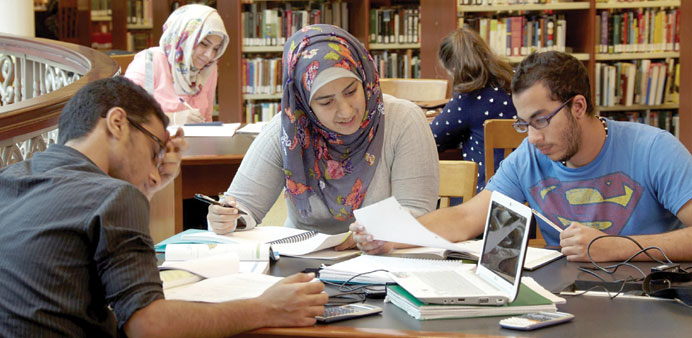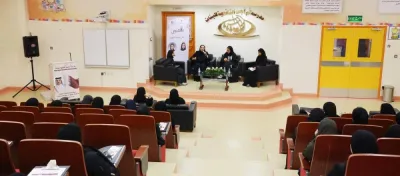EYE ON FUTURE: A representational picture of students shared by the AUS.
By Anand Holla
Student recruitment officials of American University of Sharjah (AUS) recently hosted a week-long open sessions for prospective undergraduate and graduate students in Qatar, so as to introduce them to the various accredited programmes offered by the university.
The total number of students coming from Qatar, currently enrolled at AUS, is more than 150, comprising various nationalities. The number has witnessed a big increase in the academic year 2014-2015 with indications that the growth will continue next year, say AUS officials.
At the recently held open sessions, students and parents learnt about the university’s range of academic programmes and how they help students “develop their skills in critical thinking, communication and leadership.” The students also gained insight into the university’s campus life and its vibrant multicultural atmosphere consisting of students from more than 95 countries, including Qatar.
Mohamed Sami El Shahed, AUS’ Director of Student Recruitment, holds extensive experience in admission policies and procedures, student advising and counselling, and student recruitment strategies in the Mena region. Throughout his 15-year-long stay at AUS, he has planned and delivered dozens of local, regional and international student recruitment campaigns for graduate and undergraduate programmes offered by AUS’ colleges and school. Community spoke to El Shahed to know more:
In what way do the programmes offered by AUS stand out from those offered by other universities?
Though a young university established less than 20 years ago, AUS has earned a strong reputation in the region as an institution that offers competitive academic programmes. There are several factors which have made our academic programmes stand out in the region in a remarkably short period of time. I believe these factors include the quality of our faculty members, AUS’ high admission requirements which ensures the quality of our intake, diversity of AUS students who come from more than 90 nationalities and 35 different secondary education systems, and the state-of-the-art campus. AUS offers academic programmes that meet, if not exceed, the international standards of the toughest accreditation authorities both at graduate and undergraduate levels. I also believe that AUS’ partial scholarships and financial grants schemes allow a large segment of highly qualified but financially challenged graduates of secondary education systems to join the university.
What is unique about the university scenario and student scene of Qatar?
The number of students that come from Qatar is on the rise for the last four years. The diversity of students who come from various social backgrounds, nationalities and secondary education systems are the main characteristics of our student scene in Qatar. We thank the students and parents who put their confidence in AUS.
Your programmes are devised to help students develop their skills in critical thinking, communication and leadership. How challenging is it to innovate and stay ahead of the curve?
Each programme offered by AUS is designed to provide students with both scientific depth necessary for their field of specialisation and the width and breadth of general knowledge that would make them lifetime learners and researchers. Being a not-for-profit institution, AUS allocates tremendous resources to make sure that all programmes offered by our four faculties and school cater for developing personal skills and improve students’ chances as future leaders who possess leadership and critical thinking tools and qualities.
Given your experience in student advising and counselling, and student recruitment strategies in the Mena region, could you please suggest three key points that students must bear in mind with regards to planning for higher education?
I will share five key points. First; both students and their parents must start planning for university education at least three years prior to completion of secondary education. Starting early will give them the opportunity to better prepare to meet admission requirements. Second; students and parents must develop a clear vision of the higher education opportunities available in light of their financial resources. Third; we strongly encourage students and parents to be realistic in choosing majors to study. Fourth; they must keep an eye on the dynamics and changes in the labour market four or five years from the time of joining a university. Fifth; parents and students must also consider non-traditional majors which is now becoming in demand.
Community / Culture
‘Students and parents must develop a clear vision of the higher education opportunities’



